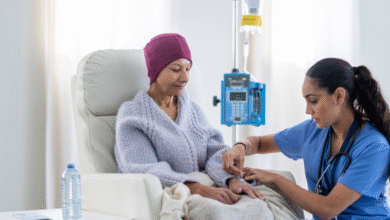Genetic Testing for Cancer: Assessing Hereditary Risk
Assessing Cancer Risk: A Genetic Perspective

What specific genetic testing options are available for individuals with a family history of cancer?
1. Single-Gene Testing:
- This type of test looks for mutations in a specific gene known to be associated with an increased risk of a particular cancer.
- It is typically used when a specific gene mutation has already been identified in a family member.
- Example: If a family member has a known BRCA1 mutation, other family members might undergo single-gene testing specifically for that BRCA1 mutation.
2. Multi-Gene Panel Testing (Hereditary Cancer Panels):
- These tests analyze multiple genes simultaneously that are known to be associated with various hereditary cancers.
- They are often used when there is a strong family history of multiple types of cancer or when the specific gene responsible is not yet known.
- Example: A hereditary breast and ovarian cancer panel might include genes like BRCA1, BRCA2, TP53, PTEN, ATM, and others associated with increased risk for these and related cancers. There are also panels for colorectal cancer, prostate cancer, and other cancer types. Some comprehensive panels can include a large number of genes (e.g., 190 genes in some tests).
3. BRCA Gene Testing:
- Specifically looks for mutations in the BRCA1 and BRCA2 genes.
- These genes are most commonly associated with an increased risk of breast, ovarian, prostate, and pancreatic cancers, as well as melanoma.
- Testing may be recommended for individuals with a personal or family history of these cancers, especially if diagnosed at a young age.
4. Lynch Syndrome Testing:
- Lynch syndrome is a hereditary condition that increases the risk of colorectal, endometrial, ovarian, stomach, small intestine, urinary tract, and other cancers.
- Genetic testing for Lynch syndrome typically involves analyzing genes like MLH1, MSH2, MSH6, PMS2, and EPCAM, which are involved in DNA mismatch repair.
- Testing may be recommended based on a family history that meets specific criteria (e.g., Amsterdam criteria or revised Bethesda guidelines) or if tumor testing (MSI or IHC) suggests a mismatch repair deficiency.
5. Testing for Other Hereditary Cancer Syndromes:
- Depending on the family history, testing may be available for other less common hereditary cancer syndromes, such as:
- Li-Fraumeni syndrome (TP53 gene): Associated with a high risk of various cancers, including sarcomas, breast cancer, leukemia, and brain tumors.
- Cowden syndrome (PTEN gene): Increased risk of breast, thyroid, endometrial cancers, and other conditions.
- Peutz-Jeghers syndrome (STK11 gene): Increased risk of gastrointestinal cancers, breast cancer, and other cancers, along with characteristic polyps and skin pigmentation.
- Familial Adenomatous Polyposis (FAP) (APC gene): High risk of colorectal polyps and colorectal cancer.
The Process of Genetic Testing:
- Consultation with a Genetic Counselor: It is highly recommended to meet with a genetic counselor before undergoing genetic testing. They can review your family history, assess your risk, discuss the available testing options, explain the potential benefits and limitations of testing, and address any ethical, legal, and social implications.
- Sample Collection: Genetic testing usually involves providing a small sample of blood or saliva. In some cases, a cheek swab may be used.
- Laboratory Analysis: The sample is sent to a specialized laboratory where the DNA is analyzed for mutations in the genes of interest.
- Results and Interpretation: The test results will be reviewed and interpreted by a genetic counselor or healthcare provider, who will explain what the findings mean for your cancer risk and recommend appropriate next steps, such as increased surveillance, preventive measures, or lifestyle changes.
How do single-site, single-gene, panel testing, and GWAS differ in their approach to genetic testing for cancer risk?
1. Single-Site Testing:
- Approach: This is the most targeted approach, looking at a specific, known genetic variant within a particular gene. It doesn’t analyze the entire gene or any other genes.
- When Used: Typically performed when a specific mutation has already been identified in a family member. The goal is to determine if other family members have inherited that same, known risk-associated variant.
- Scope: Very narrow, focuses on one specific location in the genome.
- Information Gained: Provides a “yes” or “no” answer to whether a specific known familial mutation is present.
- Clinical Utility for Cancer Risk: Useful for confirming inheritance of a known high-risk mutation within a family, allowing at-risk individuals to consider appropriate screening and prevention strategies. Not helpful for identifying new or unknown risk variants.
2. Single-Gene Testing:
- Approach: This test analyzes the entire coding sequence (and sometimes nearby non-coding regions) of a single gene to identify any variations or mutations within that gene.
- When Used: Often used when the family history or personal history strongly suggests a particular hereditary cancer syndrome associated with a specific gene (e.g., BRCA1 for hereditary breast and ovarian cancer). It’s broader than single-site testing as it can detect different mutations within that gene.
- Scope: Focused on one specific gene.
- Information Gained: Can identify various types of mutations (e.g., point mutations, insertions, deletions) across the entire gene that might increase cancer risk.
- Clinical Utility for Cancer Risk: Helps identify individuals with potentially increased risk due to mutations in a specific, well-established cancer susceptibility gene. Results can guide screening, prevention, and treatment decisions related to the cancers associated with that gene.
3. Panel Testing (Multi-Gene Panel Testing):
- Approach: This method simultaneously analyzes multiple genes that are known to be associated with an increased risk of various cancers or related cancer syndromes. Panels can range from a few genes to hundreds.
- When Used: Increasingly common, especially when there is a complex family history involving multiple types of cancer, early-onset cancers, or when single-gene testing hasn’t yielded a result but suspicion for a hereditary component remains. It can also be used as a first-line test for individuals with a significant family history.
- Scope: Broader than single-gene testing, covering a set of genes relevant to hereditary cancer risk.
- Information Gained: Can identify mutations in multiple cancer susceptibility genes, potentially explaining a broader range of cancer risks. May also identify mutations in genes with less well-established or moderate cancer risks. Can sometimes yield “variants of uncertain significance” (VUS) in multiple genes, which can be challenging to interpret.
- Clinical Utility for Cancer Risk: Efficiently assesses risk across several genes, potentially identifying the genetic basis for a family’s cancer history even if a specific syndrome wasn’t initially suspected. Results can guide personalized screening and prevention strategies tailored to the specific genes with identified mutations.
4. Genome-Wide Association Studies (GWAS):
- Approach: GWAS is a research tool that examines the entire genome of a large group of people (cases with cancer and controls without) to identify common genetic variants (single nucleotide polymorphisms or SNPs) that are associated with an increased risk of a particular cancer. It looks for associations at the population level, not necessarily within individual families with strong hereditary patterns.
- When Used: Primarily used in research to discover new genetic risk factors for common cancers. It’s not typically used in clinical practice for individual risk assessment in the same way as the other three methods.
- Scope: The broadest, scanning millions of genetic markers across the entire genome.
- Information Gained: Identifies common genetic variants that, when present in certain combinations across a population, are statistically associated with a slightly increased risk of cancer. Each individual variant typically has a small effect on risk. GWAS can help identify new genes and pathways involved in cancer development.
- Clinical Utility for Cancer Risk: The clinical utility of individual GWAS findings is currently limited.
While GWAS has identified many risk-associated variants, each usually confers only a modest increase in risk. Polygenic risk scores (PRSs) are being developed that combine the effects of many of these common variants to provide a more comprehensive estimate of an individual’s overall genetic risk for certain cancers. However, PRSs are still evolving and their widespread clinical application is under investigation. GWAS findings are more valuable for understanding the genetic architecture of cancer at a population level and for guiding future research into more clinically useful risk markers.
When is it appropriate to use each type of genetic test (single-site, single-gene, panel, GWAS)?
1.Single-Site Testing:
- Known Familial Mutation: When a specific, disease-causing mutation in a particular gene has already been identified in a family member. The purpose is to determine if other at-risk relatives have inherited the same specific variant.
- Targeted Screening: In some populations with a high prevalence of a specific mutation (e.g., founder mutations in certain ethnic groups).
2. Single-Gene Testing:
- Strong Clinical Suspicion for a Specific Syndrome: When an individual’s personal or family history strongly suggests a particular hereditary cancer syndrome linked to a specific gene (e.g., strong family history of early-onset breast and ovarian cancer pointing towards BRCA1/2).
- Distinctive Clinical Features: When an individual presents with clinical features highly characteristic of a specific single-gene disorder associated with increased cancer risk (e.g., multiple endocrine neoplasia type 1 suggesting MEN1 gene testing).
- Follow-up to Abnormal Screening: Sometimes used to investigate a specific gene highlighted by other initial screening tests.
3. Panel Testing (Multi-Gene Panel Testing):
- Complex or Unclear Family History: When there is a family history of multiple different types of cancer, early-onset cancers, or a pattern that doesn’t clearly fit a single-gene syndrome.
- Increased Risk Across Multiple Cancer Types: When an individual has a personal history of multiple primary cancers.
- Negative or Inconclusive Single-Gene Testing: When initial single-gene testing for a highly suspected gene is negative, but the family history still suggests a strong hereditary component. A panel can evaluate other relevant genes.
- Cost-Effective Broad Screening: In some cases, it can be more efficient and cost-effective to test multiple relevant genes simultaneously rather than sequentially testing single genes.
- Guiding Personalized Management: Identifying mutations in multiple genes can provide a more comprehensive understanding of an individual’s overall cancer risk and inform tailored screening and prevention strategies.
4. Genome-Wide Association Studies (GWAS):
- Research to Identify Novel Risk Factors: Primarily used in research settings to scan the entire genome of large populations to identify common genetic variants (SNPs) associated with an increased risk of specific cancers at a population level.
- Understanding the Genetic Architecture of Cancer: Helps researchers understand the complex interplay of many common genetic variants in cancer development.
- Developing Polygenic Risk Scores (PRSs): GWAS data is used to identify and weight numerous common variants to create PRSs, which can estimate an individual’s overall genetic predisposition to certain cancers. The clinical utility of PRSs is still evolving and is not yet widely used for routine clinical decision-making.
What is the role of next-generation sequencing (NGS) in cancer genetic testing?
1. Identifying Somatic Mutations for Personalized Cancer Therapy:
- Tumor Profiling: NGS is extensively used to analyze the DNA and RNA of tumor samples to identify somatic mutations (acquired during a person’s lifetime) that drive cancer growth.
- Targeted Therapy Selection: Identifying specific mutations (e.g., in genes like EGFR, BRAF, ALK) helps clinicians determine if a patient’s tumor is likely to respond to specific targeted therapies, improving treatment outcomes.
- Resistance Mechanisms: NGS can help identify mutations that contribute to drug resistance, guiding treatment adjustments.
- Comprehensive Genomic Profiling (CGP): NGS panels can analyze hundreds of cancer-related genes simultaneously, providing a broad molecular picture of the tumor.
2. Detecting Germline Mutations for Hereditary Cancer Risk Assessment:
- Inherited Cancer Syndromes: NGS panels focusing on hereditary cancer genes (e.g., BRCA1/2, TP53, MLH1) can identify germline mutations (inherited from parents) that increase an individual’s lifetime risk of developing certain cancers.
- Risk Prediction and Prevention: Identifying these mutations allows for risk assessment in individuals with a family history of cancer, enabling proactive strategies like increased surveillance, preventive surgeries, or lifestyle modifications.
- Family Member Testing: Once a germline mutation is identified in a family, NGS-based single-site testing can be used to efficiently screen other at-risk relatives.
3. Understanding Tumor Heterogeneity and Evolution:
- Intratumoral Heterogeneity: NGS can reveal the presence of multiple distinct genetic subclones within a single tumor, which can impact treatment response and resistance.
- Tracking Cancer Evolution: By analyzing serial samples (e.g., liquid biopsies), NGS can track how the genetic makeup of a tumor changes over time and in response to treatment.
4. Identifying Novel Biomarkers and Therapeutic Targets:
- Research Applications: Whole-exome sequencing (WES) and whole-genome sequencing (WGS) using NGS are crucial research tools for discovering new genes and mutations involved in cancer development.
- Drug Development: Identifying novel targets through NGS research can pave the way for the development of new cancer therapies.
5. Guiding Immunotherapy:
- Tumor Mutational Burden (TMB): NGS can quantify the number of somatic mutations in a tumor (TMB), which can be a predictive biomarker for response to immune checkpoint inhibitors in some cancer types.
- Microsatellite Instability (MSI): NGS can detect MSI, another biomarker that can predict response to immunotherapy in various cancers.
Advantages of NGS in Cancer Genetic Testing:
- High Throughput: Ability to analyze many genes or the entire genome simultaneously.
- Increased Sensitivity: Can detect rare mutations and low-frequency variants.
- Cost-Effective: For analyzing multiple genes compared to sequential single-gene testing.
- Smaller Sample Requirements: Can work with limited amounts of DNA or RNA.
- Detection of Various Variant Types: Can identify single nucleotide variants (SNVs), insertions/deletions (indels), copy number variations (CNVs), and gene fusions.
Why is genetic counseling recommended before and after genetic testing for cancer?
Genetic counseling is strongly recommended both before and after genetic testing for cancer due to the complex nature of genetic information, its potential emotional and psychological impact, and its implications for individuals and their families. Here’s a breakdown of the reasons for each stage:
Reasons for Genetic Counseling Before Genetic Testing:
- Comprehensive Risk Assessment: A genetic counselor will gather a detailed personal and family medical history to assess the likelihood of an inherited cancer predisposition. This helps determine if genetic testing is appropriate and which specific tests would be most informative.
- Education about Hereditary Cancer: The counselor will explain the principles of hereditary cancer, the genes involved in different cancer syndromes, and how mutations in these genes can increase cancer risk.
- Discussion of Testing Options: They will outline the available genetic tests (single-gene, panel, etc.), their scope, limitations, and the genes included. This ensures the individual understands what the test can and cannot tell them.
- Understanding the Potential Benefits and Limitations of Testing: Counseling helps individuals weigh the pros (e.g., risk assessment, guiding prevention) against the cons (e.g., anxiety, inconclusive results, potential for discrimination).
- Informed Consent: The counselor ensures the individual fully understands the purpose of the test, the implications of potential results (positive, negative, variant of uncertain significance), the possibility of incidental findings, and their right to decline testing.
- Emotional and Psychological Preparation: Genetic testing can evoke significant emotions. Counseling provides a safe space to discuss anxieties, expectations, and potential emotional responses to different outcomes.
- Privacy and Confidentiality: Counselors discuss the privacy and confidentiality of genetic information and the potential implications for sharing results with family members.
- Cost and Insurance Coverage: They can provide information about the cost of testing and potential insurance coverage.
- Developing a Testing Strategy: Based on the individual’s history and preferences, the counselor helps develop a tailored testing strategy that maximizes the chances of obtaining useful information.
Reasons for Genetic Counseling After Genetic Testing:
- Interpretation of Results: Genetic test results can be complex and difficult to understand without expert guidance. A genetic counselor will explain the meaning of positive, negative, or variant of uncertain significance (VUS) results in the context of the individual’s personal and family history.
- Risk Management and Surveillance Recommendations: Based on the test results, the counselor will discuss personalized recommendations for cancer screening, prevention strategies (e.g., lifestyle modifications, medications, prophylactic surgery), and early detection methods.
- Emotional and Psychological Support: Receiving genetic test results, especially a positive or VUS result, can be emotionally challenging. Counseling provides ongoing support, helps individuals cope with anxiety or uncertainty, and connects them with support resources if needed.
- Communication with Family Members: Genetic test results often have implications for other family members who may also be at risk. The counselor can help individuals understand how to share this information sensitively and offer guidance on testing options for relatives.
- Understanding Inheritance Patterns: For positive results, the counselor will explain the pattern of inheritance and the likelihood of passing the mutation on to future generations.
- Discussion of Research Opportunities: In some cases, individuals with specific genetic findings may be eligible for research studies or clinical trials. The counselor can provide information about these opportunities.
- Long-Term Follow-Up and Updates: The understanding of genetics and cancer risk is constantly evolving. Genetic counselors can provide ongoing support and updates on new research findings and recommendations related to the identified genetic risk.
- Addressing Ethical and Legal Concerns: Counselors can help navigate potential ethical and legal issues related to genetic information, such as genetic discrimination.





